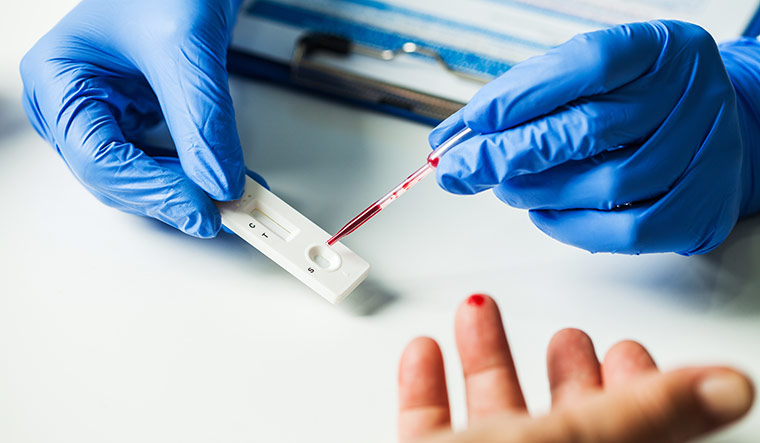Why so many tests?
How many of us can understand the sheets of paper we receive after a simple blood test? Do we require so many tests, or is it just a money-making tactic? What is the minimum knowledge we must have of pathological methods and testing? How much is too much?
According to one report, profit margins in pathologies are 23 to 25 per cent. The worrying fact is that the diagnostic industry is highly competitive, because of low entry barriers. Organised players cater to only 17 per cent of the market.
For this column, we delve into the why and how of diagnostic testing.
Dr Nilesh Shah’s qualifications include a BSc and PhD in microbiology and a DMLT (diploma in medical laboratory technology). He has 37 years of experience in his field. At 57, he is the president and chief of science and innovation at Metropolis Healthcare Limited.
Why we need to be tested on so many parameters: Comprehensive testing helps ensure good health and well-being, besides providing the clinician a detailed picture for easy decision-making. But it is essential to avoid tests that are beyond the doctor’s prescription and are irrelevant. Renowned laboratories have well-designed test packages that align with best practices. For instance, opting for a lipid profile instead of separate cholesterol and triglyceride tests can provide better value without redundancy, saving both time and money.
What do we do with 40-page reports we cannot make any sense of: Receiving lengthy reports filled with potentially irrelevant data can be overwhelming. The key is to strike a balance between thoroughness and clarity. Reports should be tailored to align with the doctor’s recommendations, focusing on relevant parameters related to the patient’s health concerns. Key findings and actionable insights should be highlighted, presented in a clear, understandable language that is accessible to non-medical professionals. A combination of detailed report and its summary helps doctors and patients understand the findings in the shortest possible time. A trend report in graphical format substantially helps decision-making.
The basic tests we require at different stages of life: Human bodies change and evolve throughout life, requiring different health checkups at different stages. While some basic tests―such as complete blood count (CBC), blood sugar, lipid, liver and kidney function tests―hold value across the board, specific needs arise at various ages and conditions.
 Shutterstock
Shutterstock
For infants and children, regular check-ups with a paediatrician ensure healthy growth and development. Key tests include monitoring vaccination status, growth metrics, developmental milestones, and basic blood-work like CBC and anaemia screening. As children grow, tests may expand to include allergy, vision and hearing checks, and dental exams.
Healthy adults generally benefit from routine checkups every one or two years, with adjustments based on individual risk factors and family history. Blood pressure monitoring, cholesterol screening, and cervical cancer screening (for women) become crucial. Depending on age and risk factors, tests for vitamin deficiencies, bone density (DEXA scan) and diabetes may be added.
During pregnancy, prenatal care involves a series of crucial tests and checkups throughout pregnancy. Screening tests such as the dual marker test (11 to 13.6 weeks), quadruple marker test (14 to 17 weeks), and non-invasive prenatal testing 10 weeks onwards) should be conducted in all pregnant females based on gestational age. Regular monitoring ensures both mother and baby’s health.
As people age, annual checkups become even more important. Colon cancer screening, glaucoma tests and cognitive assessments may be added to the routine. Managing chronic conditions often requires more frequent monitoring with specific tests relevant to the condition.
The gender differential of testing: While many essential health tests apply to everyone, regardless of gender, there are certain gender-specific considerations when optimising health checks, as they ensure a more comprehensive picture, addressing unique vulnerabilities and concerns. For men, these tests are: prostate-specific antigen (PSA) test to detect prostate cancer, and testicular exam to detect abnormalities. Semen analysis assesses fertility potential.
Women require PAP smear, which guards against cervical cancer, while mammograms screen for breast cancer. Pelvic exams evaluate reproductive organs and overall pelvic health.
There are five essential tests for all―complete blood count (CBC), cholesterol levels, creatinine levels, serum glutamic pyruvic transaminase (SGPT) levels and glucose levels. These tests offer valuable insights into various aspects of overall health, including blood cell counts, lipid profile, kidney function, liver health and blood sugar levels. By regularly monitoring these parameters, individuals can proactively manage their health and detect potential issues early on.
Are the ‘normal levels’ in various tests attuned to Indian genetics/conditions: No, our reference ranges have yet to be adjusted for the Indian population. Thus clinical involvement remains indispensable for interpreting reports effectively, especially when considering the patient’s history and symptoms. This underscores the vital role of health care professionals in contextualising the findings within the specific health context of each individual. By incorporating clinical expertise, we ensure accurate diagnosis and personalised treatment plans, ultimately optimising patient care and outcomes.
With age, there are some changes that are inevitable (example: higher lipid levels); so are tests in such cases just fear-mongering: Ageing brings about various physiological changes. For instance, lipid levels tend to increase with age, reflecting changes in metabolism and lifestyle factors. However, it is important to approach these changes with a balanced perspective and avoid unnecessary concerns. While age-related alterations in health parameters are natural, they do not necessarily indicate pathology or looming health risks. Instead, they should be viewed within the broader context of an individual’s overall health and well-being.
Different tests may exhibit different patterns of change with age. For example, while white blood cell (WBC) count typically decreases with age, levels of follicle-stimulating hormone (FSH) in women tend to increase. Understanding these nuances is essential for better understanding.
Important issues about pathological tests that a layman should understand: There are two fundamental points. Selecting the right tests is vital to prevent over-testing, which can be as harmful as under-testing. Targeted tests for specific health concerns minimise unnecessary procedures, reduce costs and lower the risk of false positives or unnecessary interventions. Second, consulting a qualified health care professional is essential for interpreting test results accurately. Their expertise contextualises results within the patient’s medical history and symptoms, guiding personalised treatment plans or preventive measures. Collaboration between patients and health care professionals optimises the value of diagnostic tests, enhancing health outcomes and informed decision-making.
The question of trust and confidence: Evidence-based medicine is a widely accepted norm in the recent era. As a result, undergoing diagnostic tests should also be embraced. Patients should place their trust in the clinician’s experience with diagnostic centres, in addition to considering laboratory accreditations and the overall brand image.
Regarding doctors, the initial screening should involve assessing accreditation, test menu, technology adoption, team credentials, proficiency test performance, service levels and published NPS (net promoter score). A personal visit to the laboratory and meeting the key team members is a crucial step in building confidence.
A primer on technologies: New-age technologies can be categorised into two distinct realms, emphasising that their applications differ significantly though the underlying technologies may be the same. The first category encompasses technologies related to equipment and machinery, while the second category focuses on pure IT solutions.
Multiplexing: A technique employed in various fields, including molecular diagnostics and immunoassays. Multiplexing enables the retrieval of multiple answers from a single test, exemplified by immunoassay multiplexing tests that can assess numerous allergies simultaneously. Additionally, this molecular method facilitates the evaluation of infections in one comprehensive analysis.
Microarray: Microarrays, resembling small chips, feature coatings of multiple substances. These arrays serve diverse purposes, such as assessing food intolerances. With up to 210 different particles or components on a single chip, microarrays efficiently deliver comprehensive test results.
Next-generation sequencing: NGS, despite being over a decade old, has evolved significantly in terms of applications, automation and customisation for diagnostic purposes. It now finds utility in cancer workup, infection diseases, gut microflora analysis and tuberculosis diagnostics, among others.
Mass spectrophotometry: Although a technology in use for 20 to 25 years, mass spectrophotometry has recently gained traction in clinical applications. Tandem mass spectrometry enables the identification of bacteria and organisms at the gene level.
In the semi-IT domain, IT is integrated with equipment to enhance functionality:
Haematology: In this field, digitised pathology has achieved remarkable precision. Scanners analyse slides, and doctors perform image analysis, leading to a 99 per cent accuracy rate. Immunofluorescence employs similar technology for positive/negative identification and pattern recognition.
Cytology: IT-assisted analysis identifies positive and negative areas, aiding doctors in their assessment.
Histology: Image analysis software enables scoring of slides, streamlining the diagnostic process.
Urine Analysis: Automation has optimised urine microscopy, allowing for fully automated analysis.
Within the middle IT sector, technologies with a history of 10 to 15 years are gaining renewed acceptance, particularly in reputable organisations:
Auto validation: Automation plays a crucial role in assessing calibrations and controls, determining if they adhere to norms and should be accepted.
Moving averages: Moving averages provide ongoing system monitoring by calculating the mean of results. Any deviations trigger system alerts, significantly enhancing quality control compared to previous methods.


